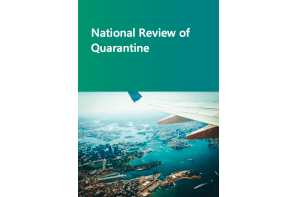In the absence of widespread immunity providing protection against the health effects of COVID-19, limiting the entry and spread of the virus has been a key public health objective. In addition to other non-pharmaceutical interventions (NPIs), mandatory quarantine has played a key role in Australia’s public health response for both domestic and international travellers.
The Australian quarantine system was stood up quickly in response to the immediate threat from COVID-19 – from a standing start to fully operational over a weekend – following a decision at the National Cabinet on 28 March 2020. This was done to meet immediate needs: keep COVID-19 out of Australia, manage case numbers in the community and flatten the epidemiological curve of new cases to help preserve life and provide time to prepare the public health and hospital system response. There was no best practice quarantine handbook and arrangements were developed on a state-by-state basis.
In that context, and in the absence of large-scale dedicated facilities, hotels became the mainstay of the quarantine system for international travellers and have been a key part of Australia’s health response to COVID-19. Since 28 March 2020, when mandatory quarantine commenced, approximately 452,550 international air arrivals have been through the system. A large but unknown number of domestic travellers have also undertaken mandatory hotel quarantine as they have moved from state to state.
Following a number of transmission events between COVID-19 positive arrivals and quarantine workers, the first National Review of Hotel Quarantine (the first review) was commissioned by the National Cabinet. The review report was released on 23 October 2020 after quarantine arrangements had been in place for seven months. At that time, understanding of COVID-19 and its variants, how to contain the virus, and best practice quarantine arrangements were evolving. While vaccine development had commenced, the time required to develop vaccinations and prospects of success were unknown.
This review comes at a time of increased complexity. There are more quarantine options, travellers and Australians are increasingly vaccinated, and improved and more flexible testing arrangements are available to provide assurance and early detection of infectivity. The risk of COVID-19 developing in recent international arrivals during their quarantine period given pre-departure testing and vaccination is very low, indeed lower than the risk of endemic COVID-19 in at least two states.
The review is structured in three main sections:
- System performance over the previous 18 months including what has changed since the first review, vaccine rollout, the emergence of the Delta variant and implementation of the first review’s recommendations;
- Current system operations, including risk mitigations to prevent COVID-19 transmission events in the context of phase A of the National Plan; and
- Future use of quarantine, and implementation issues, during phases B-D including the need for a framework that can support increased quarantine capacity and manage transmission risks.
Download full report at: https://apo.org.au/node/315124?mc_cid=bd260c8708




